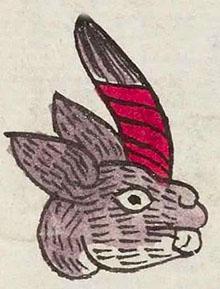Tochtzonco (Mdz48r)
This compound glyph for the place name Tochtzonco contains two elements, a rabbit (tochtli) and a lock of human hair (tzontli) from the top of a head. A tzontli is also a number, standing for four hundred. The rabbit is only shown as a head, in profile, looking to the viewer's right. It is a textured gray-purple color, with white under the chin, white fangs, and a white (open) eye. The tzontli is upright, the hair comes to a point at the top, and the lower half is wrapped with what is a red tie, perhaps a tochacatl. The locative suffix (-co), at or by, is not shown visually.
Stephanie Wood
If the tie is not a cord, it may be made of leather. A similar red leather tie is called a "cinta de cuero rojo," employed in the process of tying up one's hair to be converted into a warrior, according to Guy Stresser-Péan (1995, 45). (See our Bibliography for the full citation to his study.)
tuchçonco.puo
Tochtzonco, pueblo
Stephanie Wood
c. 1541, but by 1553 at the latest
Stephanie Wood
conejos, cuatrocientos, cabello envuelto, colmillos, nombres de lugares

toch(tli), rabbit, https://nahuatl.wired-humanities.org/content/tochtli
tzon(tli), 400 or a lock of human hair, https://nahuatl.wired-humanities.org/content/tzontli
-co (locative suffix), https://nahuatl.wired-humanities.org/content/co
temilo(tli), a warrior hairstyle, https://nahuatl.wired-humanities.org/content/temilotli
tlatzonilpia, to tie up the hair, https://nahuatl.wired-humanities.org/content/tlatzonilpia
Codex Mendoza, folio 48 recto, https://digital.bodleian.ox.ac.uk/objects/2fea788e-2aa2-4f08-b6d9-648c00..., image 106 of 188.
The Bodleian Libraries, University of Oxford, hold the original manuscript, the MS. Arch. Selden. A. 1. This image is published here under the UK Creative Commons, “Attribution-NonCommercial-ShareAlike 3.0 License” (CC-BY-NC-SA 3.0).




